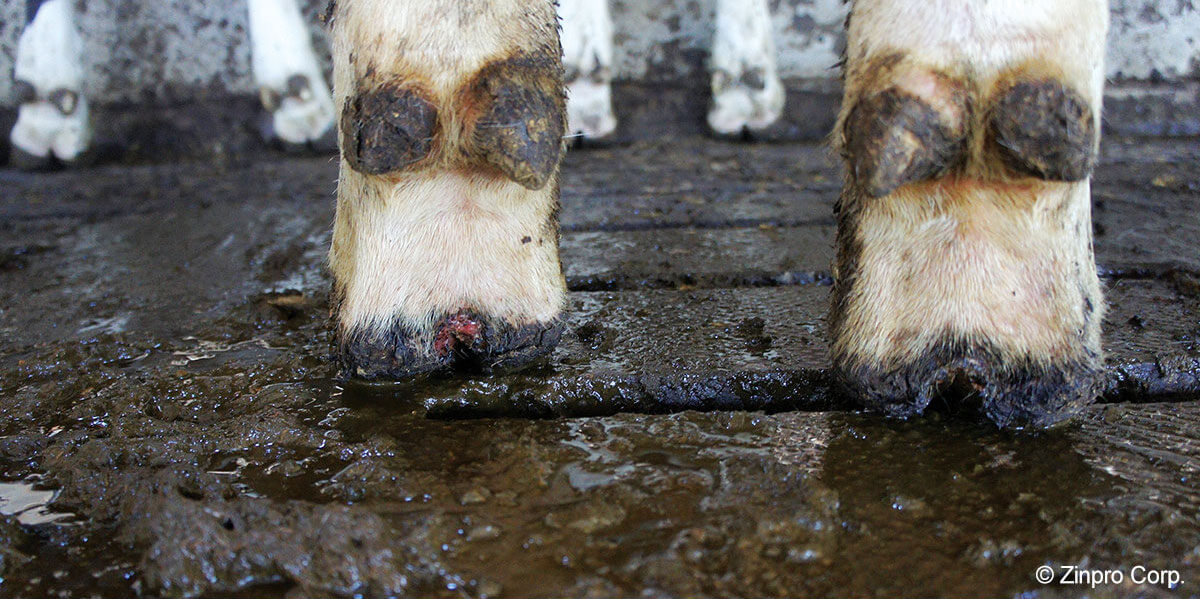- Digital dermatitis has been reported on 70 percent of all U.S. dairies and on 95 percent of large operations comprising 500 or more cows.
- It’s the leading cause of lameness in dairy cattle in the United States with prevalence estimates as high as 80 percent.
- The disease often leads to lameness, which decreases milk production, performance and fertility in cattle.
- In beef, lameness can account for 70 percent of all sales of non-performing cattle.
Digital dermatitis is often referred to as hairy heel warts and is a common infectious foot disease that causes lameness in cattle. Managing digital dermatitis is an ongoing challenge as it is a highly contagious foot disease and there are very limited ways to control it.
What We Know About Digital Dermatitis
The industry has been researching digital dermatitis for more than 40 years, yet we still do not understand its exact relationship between the causal factors. Clinical lesions have been well described, but more is needed to know about the morphologic changes that are associated with the initial stages of lesion development from normal skin to clinical lesions.
Dairy heifers appear to be most susceptible to digital dermatitis infections around puberty, and heifers that have warts can potentially experience digital dermatitis for life. On the other hand, heifers that don’t have warts in the growing period, are at less risk of developing lesions during their first lactation.
To develop and run rampant, digital dermatitis needs bacteria, primarily a spirochetal species of anaerobic bacteria known as Treponema. Treponemes can be found on healthy skin, but they also need moisture to grow and compromised skin integrity — a point of entry into the body. Treponema thrives in a low-oxygen environment … manure slurry is a good skin conditioner for priming a point of entry for digital dermatitis to take hold.
The dairy industry has extensive experience with digital dermatitis, and dairy operations have managed the disease using footbaths that cows walk through between the milking parlor and barns. However, in recent years the disease has increasingly shown up in beef feedlots, where the use of footbaths is more difficult to implement.
What We Don’t Know About Digital Dermatitis
Why are beef feedlots seeing an increase in digital dermatitis? This is somewhat unknown, and Dr. Paul Plummer, an assistant professor of veterinary diagnostic and production animal medicine at Iowa State University is conducting research to explore the cause.
Plummer’s research showed that a majority of cows that contracted the disease weren’t lame to begin with, a finding that has implications for how dairy and beef producers should track the disease.
Other findings from the Iowa State research include the following:
- Single treatments do not eliminate the lesions, and only about 10 percent of the lesions are permanently eliminated. The remaining lesions return months later, and Iowa State University is looking at how changes in early therapy could alter this.
- Since this is a relatively new disease to the beef cattle industry, producers don’t know how to treat the disease, and Iowa State University is looking at ways to produce effective treatments in beef feedlots.
- Earlier detection of the lesions is critical in the eventual treatment of the disease.
Performance Trace Minerals Offer a Solution for Digital Dermatitis
Traditional methods for treating digital dermatitis, such as footbaths, work from the outside in. To effectively control digital dermatitis, there needs to be an integrated prevention and control strategy that manages risk factors involved including: management, hygiene and nutrition.
Research has shown that feeding the performance trace minerals found in Availa® Plus as part of a specific DD Formula in a well-fortified diet, can help provide sufficient trace minerals to maintain good health. This carefully formulated trace mineral program works internally to enhance the animal’s health. A healthy animal will have good claw/hoof integrity, reproduction/fertility rates, milk quality, average daily gain, as well as good feed efficiency/conversion. In addition, when an animal has the proper balance of trace minerals it is better able to cope with the challenging effects of stress.
Availa-Plus represents an entirely new approach to foot health management. The performance trace minerals found in Availa-Plus, when fed as part of a well-fortified diet in conjunction with a specific DD Formula, have been shown to sustain animal health and make cattle less susceptible to the bacteria that cause digital dermatitis.
Feeding performance trace minerals doesn’t eliminate the need for foot bathing. The cattle may still have lesions, but they’re typically not large, painful active lesions. This represents a significant cost savings not only in the investment in chemicals and the footbath but also, in time, the benefit that we see is reduced digital dermatitis.
“Our team of Zinpro experts are ready to help you win the battle against digital dermatitis. Contact them today to build a plan that is right for your business.”

